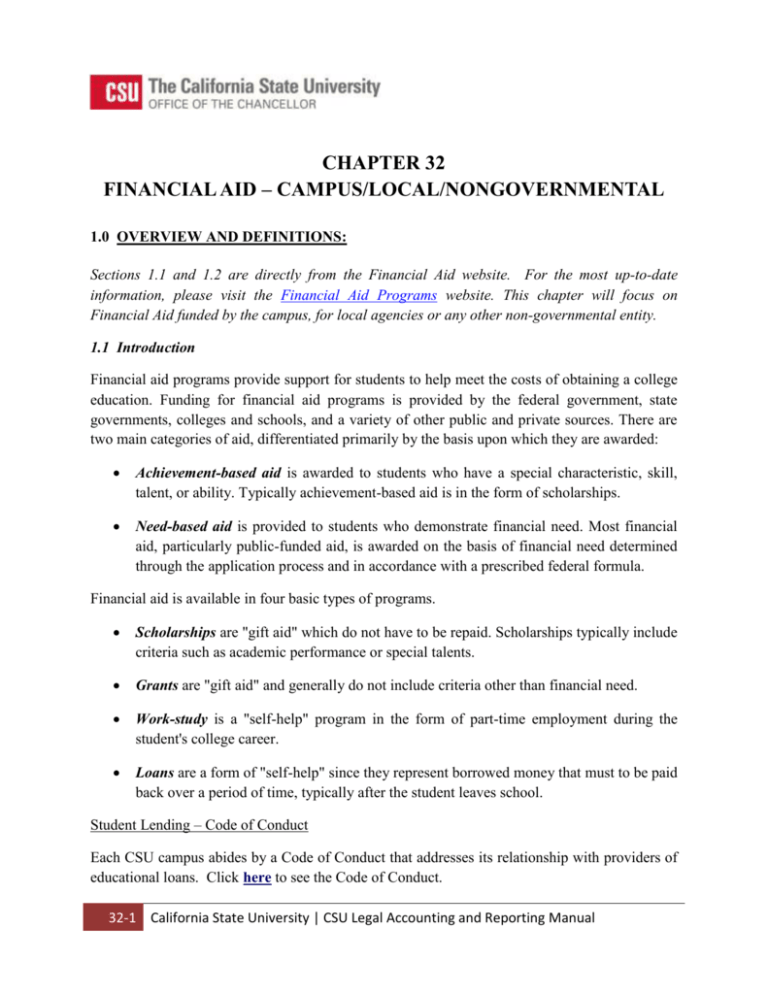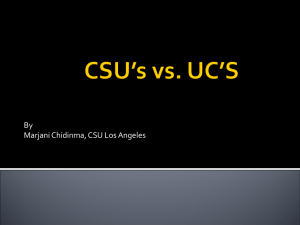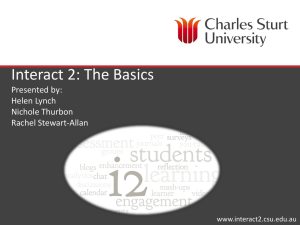Financial Assistance - Campus/Local/Non
advertisement

CHAPTER 32 FINANCIAL AID – CAMPUS/LOCAL/NONGOVERNMENTAL 1.0 OVERVIEW AND DEFINITIONS: Sections 1.1 and 1.2 are directly from the Financial Aid website. For the most up-to-date information, please visit the Financial Aid Programs website. This chapter will focus on Financial Aid funded by the campus, for local agencies or any other non-governmental entity. 1.1 Introduction Financial aid programs provide support for students to help meet the costs of obtaining a college education. Funding for financial aid programs is provided by the federal government, state governments, colleges and schools, and a variety of other public and private sources. There are two main categories of aid, differentiated primarily by the basis upon which they are awarded: Achievement-based aid is awarded to students who have a special characteristic, skill, talent, or ability. Typically achievement-based aid is in the form of scholarships. Need-based aid is provided to students who demonstrate financial need. Most financial aid, particularly public-funded aid, is awarded on the basis of financial need determined through the application process and in accordance with a prescribed federal formula. Financial aid is available in four basic types of programs. Scholarships are "gift aid" which do not have to be repaid. Scholarships typically include criteria such as academic performance or special talents. Grants are "gift aid" and generally do not include criteria other than financial need. Work-study is a "self-help" program in the form of part-time employment during the student's college career. Loans are a form of "self-help" since they represent borrowed money that must to be paid back over a period of time, typically after the student leaves school. Student Lending – Code of Conduct Each CSU campus abides by a Code of Conduct that addresses its relationship with providers of educational loans. Click here to see the Code of Conduct. 32-1 California State University | CSU Legal Accounting and Reporting Manual FINANCIAL AID – CAMPUS/LOCAL/NONGOVERNMENTAL 1.2 Aid Programs Administered by the California State University The CSU maintains efforts to ensure educational opportunity for all students. In addition to the significant state subsidy provided to all students who enroll at the CSU, reflected by its low fee structure, the CSU also dedicates a significant amount of its revenues to need-based grants each year. State University Grant (SUG) - provides need-based awards to cover a portion of the state tuition fee for eligible undergraduate, graduate, and post-baccalaureate students who are California residents or are otherwise determined as eligible. Systemwide, the priority is to award a SUG at least equal to the amount of the state tuition fee to eligible students who apply for financial aid by March 2nd, who have an expected family contribution (EFC) of $4,000 or less, and who are not receiving a Cal Grant or other award designated to cover fees. Funding for this program is limited. Students must re-apply for consideration every year. SUG awards are limited based on the number of units a student has earned and the published length of their academic program. For more complete information, review the financial aid web site(s) of the individual campuses. Educational Opportunity Program (EOP) Grant - provides assistance to economically and educationally disadvantaged undergraduates. Recipients must be California residents who are admitted to a CSU campus through the Educational Opportunity Program. EOP students may receive a grant, based on need, of up to $2,000 per year. 1.3 Aid Programs Administered by CSU Campuses Scholarships - The availability and application procedures for institutional scholarships vary among the campuses. Other Aid Programs - The availability of other aid programs varies among institutions. Several CSU campuses have small institutional long-term loan programs and a number of them currently participate in the state Work-Study Program. For questions regarding the above sections, campuses should first contact their campus Financial Aid Office for assistance. 32-2 California State University | CSU Legal Accounting and Reporting Manual FINANCIAL AID – CAMPUS/LOCAL/NONGOVERNMENTAL 2.0 FUND SPECIFICS: 2.1 FIDUCIARY – PRIVATE PURPOSE FUNDS Financial Aid Funds 2.1.1 CSU Fund 423, Forgivable Loan/Doctoral Incentive Program: Used to record the loans, support and operating costs related to the California Doctoral Incentive Program (CDIP). Authority: EC 89721(b) and established via Grantor Agreement. 2.1.2 CSU Fund 431, TF-Campus Scholarships and Grants-Restricted: Used as a campus scholarship/grant fund. This fund is used for miscellaneous non-federal scholarships and grants. Authority: EC 89721(b) and established via Financial Aid Regulations. 2.1.3 CSU Fund 433, Campus Students Loans Trust: Used to record campus-administered student loan funds that are not required to be accounted for elsewhere. Funding is provided from contributions, repayments of previous loans, and interest income. Examples include short-term and emergency loan funds. Authority: EC 89721(b) and established via Financial Aid Regulations. 2.1.4 CSU Fund 434, Campus Student Long Term Loans: Used to record campusadministered student long-term loans that are not required to be accounted for elsewhere. Funding is provided from contributions, repayments of previous loans, and interest income. Authority: EC 89721(b) and established via Financial Aid Regulations. 2.1.5 CSU Fund 435, Miscellaneous Financial Aid – Unrestricted: This campus fund is used to record financial aid activity funded by unrestricted sources. Authority: EC 89721(b) and established via Financial Aid Regulations. 32-3 California State University | CSU Legal Accounting and Reporting Manual FINANCIAL AID – CAMPUS/LOCAL/NONGOVERNMENTAL 2.2 FIDUCIARY – AGENCY FUNDS Financial Aid Funds 2.2.1 CSU Fund 436, Miscellaneous Financial Aid and Other Agency: Used to record funds held by the campus on behalf of another agency and, as such, transactions generally occur only in balance sheet accounts. When a campus receives scholarship monies in which the scholarship recipients have been determined by another agency, the campus is acting as their agent. This fund should not be used for Federal Direct Loans (which are accounted for in CSU fund 410, Federal Direct Student Loans). Authority: EC 89721(b) and established via Financial Aid Regulations. 3.0 FUND MANAGEMENT AND ACCOUNTING PRACTICES: 3.1 FIRMS Edit Table During the FIRMS data validation process, campus data will be checked to verify that only financial aid object codes are being used in the funds referenced in this chapter. See Chapter 3, FIRMS, for further information about the Legal Edits Table, which validates combinations of CSU fund and object code. 3.2 Recording SUG and EOP in the General Ledger SUG and EOP cash will remain in the CSU Operating Fund (CSU fund 485) and will be expensed directly from this fund as disbursed to students. Unique object codes are to be used to record SUG and EOP expenditures to differentiate these from other activity in the CSU Operating Fund, making them easily identifiable for CSU budgetary reporting to the state and to allow for proper classification of SUG and EOP amounts for GAAP reporting purposes. Campuses should use FIRMS object code 609001, State Educational Opportunity Program Grant, and 609002, State University Grant, in CSU fund 485 for direct expensing of EOP and SUG disbursed to students. The Student Financial system should be set up with the appropriate item types so that these object codes and CSU fund 485 are used to record the financial aid disbursements. Item types are codes used in the Oracle Student Financials module to define all of the unique actions seen in student accounts such as Tuition Deposits, Financial Aid Payments, Waivers, Application Fees, Interest charges, and Refunds. Item types are mapped to general ledger accounts and thus determine how student account information is transferred to the General Ledger. 32-4 California State University | CSU Legal Accounting and Reporting Manual FINANCIAL AID – CAMPUS/LOCAL/NONGOVERNMENTAL Special Note for SUG and EOP: For campuses that treat summer as a trailer term, the unspent financial aid should be accrued in the legal books to properly account for the entire amount awarded to students. A trailer term is a term that follows the Spring term, but which does not go into the next academic year. If financial aid has been granted, but was not used by a student for the previous Fall or Spring terms, it can be used in a trailer term. In addition, a year-end fund balance designation entry to FIRMS object code 304021, Fund Balance Designated for Financial Aid, is required for these amounts, and an explanation will need to accompany the annual carryforward report to the Systemwide Budget Office. (See Chapter 14, CSU Operating Fund, Section 5.1 and 5.2, for further information concerning the carryforward report.) Please also see Chapter 14, CSU Operating Fund, Section 3.7, Guidelines for Financial Aid Funded from Student Fees, for further details related to SUG and EOP. 3.3 Recording Other Financial Aid Programs Funded From Student Fees There are two other primary financial aid programs at the campus that are recorded in CSU fund 485: the Graduate Business Professional Fee (GBPF) and the financial aid set-aside for doctoral programs. 3.3.1 Graduate Business Professional Fee (GBPF) Campuses are directed to set aside 25% to 33% of GBPF as a provision for financial aid. For tracking and reconciliation purposes, a separate campus fund should be established within CSU fund 485 for the provision. The unexpended balance at year end should be reported using the FIRMS object code 304021, Fund Balance Designated for Financial Aid, to avoid inflating unexpended balances in CSU fund 485 that are available for general operations. There is no expense FIRMS object code for GBPF since GBPF is a funding source rather than a separate financial aid program and the financial aid disbursements from GBPF are made through existing financial aid programs. If the set-aside is higher than the financial aid need for a particular academic year, the balance of the GBPF remaining after the set-aside can be recorded in the campus main operating fund. 32-5 California State University | CSU Legal Accounting and Reporting Manual FINANCIAL AID – CAMPUS/LOCAL/NONGOVERNMENTAL 3.3.2 Financial Aid Set-Aside for Doctoral Programs: The following doctoral programs exist within the CSU: Doctor of Education (Ed.D.) Doctor of Physical Therapy (D.P.T.) Doctor of Nursing Practice (D.N.P.) Fees charged to doctoral students are not considered a state tuition fee and are, therefore, ineligible for the SUG. The doctoral program set-aside, however, functions in much the same way as the SUG. The campus projects the tuition revenues to be collected annually, applies the appropriate set-aside percentage and then uses those funds to make the doctoral financial aid awards. The doctoral program, in consultation with other departments as appropriate, determines the annual amount of the doctoral set-aside, in accordance with the Trustee resolution. The set-aside percentages are as follows: EdD 10% - Per EO 1054 DNP 20% - Per resolution RFIN 07-11-08 DPT 33.3% - Per resolution RFIN 07-11-09 Please also see Chapter 14, CSU Operating Fund, Section 3.5, Guidelines for Financial Aid Funded from Student Fees, for further details related to the recording of these programs in CSU fund 485. 3.4 Specific Considerations for CSU Fund 431, TF-Campus Scholarships and GrantsRestricted Each campus should analyze the monies in this fund to determine whether they should be treated as restricted or unrestricted. The funds should be restricted if the restriction as to the use of funds is imposed by the grantor, contributor or by law. For example, if a grantor indicates that the funds may only be used for scholarships, the funds received are deemed to be restricted. The funds are considered unrestricted if there is no externally imposed restriction on use. If the grantor selects the student recipients of a scholarship or grant, the scholarship or grant should be classified as an agency transaction since the campus is only serving as an agent to the grantor. If the campus has the ability to select the recipient student, or has the ability to redirect the grant or scholarship, the campus should record the revenue and related expense as part of 32-6 California State University | CSU Legal Accounting and Reporting Manual FINANCIAL AID – CAMPUS/LOCAL/NONGOVERNMENTAL restricted net position. The revenue should be recorded to the appropriate 503XXX financial aid FIRMS object code. The scholarship expense object code, 609005, Other Student Scholarships/Grants, should be used when issuing the scholarship to the recipient. 3.5 Specific Considerations for CSU Fund 436, Miscellaneous Financial Aid and Other Agency When a campus receives scholarship monies for which the scholarship recipients have been determined by another agency, the campus is acting as their agent. Therefore, monies recorded in CSU fund 436 should be recorded in the FIRMS liability object code 206700, Depository Accounts–Noncurrent, or 206701, Depository Accounts-Current. Upon issuing the scholarship, campuses are to offset this same liability account. No revenue or expenses are to be recorded in conjunction with these types of transactions. This fund should not be used for Federal Direct Loans (which are accounted for in CSU fund 410). See Chapter 30, Financial Aid - Federal, for further details regarding CSU fund 410. Scholarship funds received from the California State University Foundation for the CSU Trustee Awards are also considered agency transactions and should be recorded in CSU fund 436. Though campus financial aid departments nominate eligible candidates, the CSU Foundation selects the student recipients of a scholarship. Therefore, the campus is only serving as an agent to the grantor. The campus should record the money to FIRMS object code 206701, Depository Accounts-Current. The accounting described above will allow the entries to be easily eliminated for purposes of GAAP reporting. 3.6 Specific Considerations for Scholarship Awards In some cases, grants received will include a provision for student scholarships. The overriding purpose of the grant is not to provide financial aid, and so the accounting for the grant is done in CSU fund 465, Grants and Contracts. The funds for scholarships are a very small portion of the monies received under the grant. The scholarship funds provided may be for students of the campus receiving the grant and/or for students at other CSU campuses. When scholarship funds are given by the grantee campus to another CSU campus it is necessary to eliminate the resultant duplication of revenue and expense entries. The necessity for elimination depends on whether the receiving campus is an active participant in the transaction or is simply an agent for the grantee campus. The distinction is discussed further below and in the examples provided in this section. 32-7 California State University | CSU Legal Accounting and Reporting Manual FINANCIAL AID – CAMPUS/LOCAL/NONGOVERNMENTAL The recipients of the scholarships may be determined by the grant, by the campus administering the grant or by the campus issuing the scholarship funds. When a campus disburses monies in which the scholarship recipient has been determined by the grant, the campus is acting as their agent. Therefore, monies recorded in CSU fund 431 should be recorded in FIRMS liability object code, 206701, Depository Accounts-Current. Upon issuance of the scholarship, this same liability account is to be charged. No revenue or expenses are to be recorded in conjunction with these types of transactions. If the campus has the ability to select the recipient student, or has the ability to redirect the grant or scholarship, the campus should record the revenue and related expense as part of restricted net position. The following examples demonstrate the journal entries to be prepared on a legal basis for the alternative relationships between the grantee and the campus disbursing the scholarship funds: Scenario 1 – Campus A receives a grant and sends Campus B a scholarship award from the grant. Campus B determines which students receive the scholarship. Campus A Dr. CSU fund 465, FIRMS object code 101100 – Short Term Investments/Cash (SWIFT) Cr. CSU fund 465, FIRMS object code 503XXX [financial aid revenue object codes] To record receipt of the grant. Campus A Dr. CSU fund 465, FIRMS object code 624101, SP Interagency Scholarships (w/F&A) Cr. CSU fund 465, FIRMS object code101100 – Cash/Short-Term Investments (SWIFT) To issue the scholarship funds to Campus B. Note: Campus A employs a special FIRMS object code when recording the scholarship expense (624101). It is important for campuses to use this object code when recording transactions like this since it allows the Chancellor’s Office to identify them for purposes of recording a GAAP elimination. Campus B Dr. CSU fund 431, FIRMS object code101100, Cash/Short-Term Investments (SWIFT) Cr. CSU fund 431, FIRMS object code 503302, Local Financial Aid Grants, Noncapital To record scholarship funds transferred by Campus A. 32-8 California State University | CSU Legal Accounting and Reporting Manual FINANCIAL AID – CAMPUS/LOCAL/NONGOVERNMENTAL Campus B Dr. CSU fund 431, FIRMS object code 609005, Other Student Scholarships/Grants Cr. CSU fund 431, FIRMS object code101100, Cash/Short-Term Investments (SWIFT) To record issuance of scholarship to a student designated by Campus B. Note: Campus A will need to provide information to the Chancellor’s Office about these transactions so the duplicate revenue and expense can be eliminated for GAAP reporting purposes. Campus A will need to notify the Chancellor’s Office of the amount it recorded in revenue and expense for these scholarships, confirm the fund and object codes used, and identify the receiving campus. Scenario 2 – Campus A receives a grant and sends Campus B the funds to issue the scholarships on their behalf. Campus A determines the recipients, therefore, campus B will record an agency transaction. Campus A Dr. CSU fund 465, FIRMS object code 101100, Cash/Short-Term Investments (SWIFT) Cr. CSU fund 465, FIRMS object code 503XXX [financial aid revenue object codes] To record receipt of the grant. Campus A Dr. CSU fund 465, FIRMS object code 624001 or 624002, SP Scholarships Cr. CSU fund 465, FIRMS object code 101100, Cash/Short-Term Investments (SWIFT) To record issue of funds to Campus B for payment of scholarship to specified student. Note: Do not use FIRMS object code 624101, SP Interagency Scholarships (w/F&A), as this is only used in when both the issuing and receiving campuses record the scholarship revenues and an elimination is required in GAAP. Campus B Dr. CSU fund 436, FIRMS object code101100, Cash/Short-Term Investments (SWIFT) Cr. CSU fund 436, FIRMS object code 206701, Depository Current To record receipt of the scholarship funds on behalf of Campus A. 32-9 California State University | CSU Legal Accounting and Reporting Manual FINANCIAL AID – CAMPUS/LOCAL/NONGOVERNMENTAL Campus B Dr. CSU fund 436, FIRMS object code 206701, Depository Current Cr. CSU fund 436, FIRMS object code 101100, Cash/Short-Term Investments (SWIFT) To record issuance of the scholarship to a student specified by Campus A. 3.7 Graduate Equity Fellowship The recording of the Graduate Equity Fellowship depends on the funding source for the fellowship. If it is funded from student fee revenues in CSU fund 485, as seems most likely, then financial aid expenses for the program should be recorded in CSU fund 485 using FIRMS object code 609004, State Graduate Fellowship. Campuses may create a separate PeopleSoft account that maps to FIRMS object code 609004 to track fellowship expenses separately from other state graduate fellowship programs, if any. 4.0 REPORTING REQUIREMENTS: None 5.0 FUND BALANCE: FIRMS object code 304021, Designated for Financial Aid, was created only for campuses that treat summer as a trailer term for financial aid purposes. Therefore, campuses should typically accrue on their legal books any unspent amounts that have been awarded for the summer term. In cases where 100% of the SUG or EOP amounts for a year have not been spent or properly accrued for award to a student, a designated reserve should be recorded for those amounts within CSU fund 485 and an explanation should be provided in the annual carryforward report to the Systemwide Budget Office. There are no equity accounts for financial aid and student loan funds, and for financial aid funds held on behalf of others (agency funds); therefore, there is no fund balance at the end of the fiscal year in these funds. 6.0 GAAP IMPACT: There is a need for GAAP entries for tuition discounting (see GAAP Manual Chapter 4.11 for further information) and any adjustment for summer term trailer accruals (see GAAP Manual Chapter 4.13 for further information). 32-10 California State University | CSU Legal Accounting and Reporting Manual FINANCIAL AID – CAMPUS/LOCAL/NONGOVERNMENTAL 7.0 RESOURCES: Financial Aid Programs GAAP Manual Legal Edits Table 32-11 California State University | CSU Legal Accounting and Reporting Manual FINANCIAL AID – CAMPUS/LOCAL/NONGOVERNMENTAL REVISION CONTROL Document Title: CHAPTER 32 – FINANCIAL AID – CAMPUS/LOCAL/NONGOBERNMENTAL Contributor: Kristina Randig Reviewer: Dean Kulju/Wendy Ortega CO Owner: Roberta McNiel Issuance Date: May 29, 2014 Revision and Approval History Section(s) Revised Summary of Revisions Revised By Reviewed by Approved by Revision Date Click here to enter Sections Revised. Click here to enter Summary of Revisions Click here to enter name of Person Revising. Click here to enter name of Reviewer Click here to enter name of Approver Click here to enter Revision Date 32-12 California State University | CSU Legal Accounting and Reporting Manual









